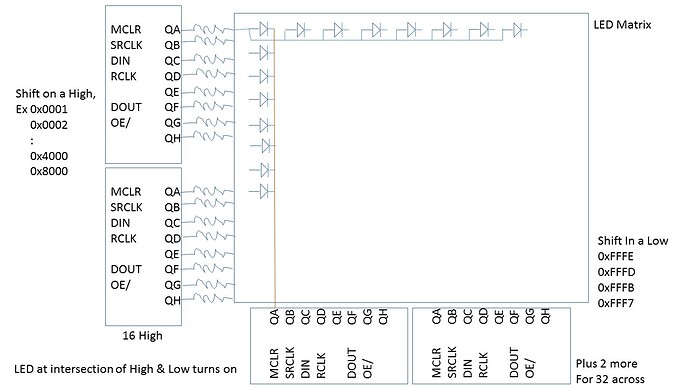hello guys, i have encountered a problem on my simple experiment
my main objective is to simply light up an single LED, one at a time, for example, [4][12], an LED located in row 4 and column 12, basically i have 512 LEDs but i dont know which component to use to be able to manipulate such a large amount of led considering i only have few pins
i saw a lot of tutorial on youtube, but they function by outputting complex displays such as Characters and numbers, i only need simple display(to lit up LEDs one at a time)
i'm confused to what extra component to use with my arduino
Use exactly the same hardware, just don't multiplex it in software if that is what you want.
but i dont know which hardware to use sir, i'm new to arduino
bennaseef:
but i dont know which hardware to use sir, i'm new to arduino
There are lots of different designs you could use, the net is full of them.
Are you planning to use a ready built matrix or make them out of 512 individual LEDs?
Thank you for being patient with me sir Grumpy, now i've come to realize how good the led strip ws2812b, correct me if i'm wrong, about the info i have gathered sir, the led strip ws2812b only uses 1 pin while having an IC internally already right? i live far from the city (a primitive province actually) and access to this stuff are extremely hard.
led strip ws2812b only uses 1 pin while having an IC internally already right? i
Yes that is correct. It makes the wiring very much simpler. You can get these LEDs in a strip, individual surface mount parts, or a 5mm or 10mm through hole part.
16 x 32 is pretty straightforward, just need 6 shift registers, 6 0.1uF caps, 16 current limit resistors, and 512 LEDs.
For having 1 LED on at a time, shift in a high bit on the anode side, shift on a low bit on the cathode side, the LED at the intersection is the one that will turn on.
Then to update the display, just send out 6 bytes. I like using SPI.transfer(), you could also use shiftOut()
digitalWrite (ssPin, LOW);
SPI,transfer(anodeByte0);
SPI.transfer(anodeByte1);
SPI.transfer(cathodeByte0);
SPI.transfer(cathodeByte1);
SPI.transfer(cathodeByte2);
SPI.transfer(cathodeByte3);
digitalWrite (ssPin, HIGH); // all outputs update on this rising edge
Could have an unsigned int to hold the anode data, and an unsigned long for the cathode data, and break off the 8 bit bytes to send out as another means of data control.
With WS2812B, you need to send out 3 bytes per LEDs, so 1536 total, using the Neopixel library from Adafruit for example, to update any 1 location.
You do get the advantage of 256 levels of RGB per pixel. But power needed goes up a lot. For full white, all 3 LEDs are turned on drawing 60mA/pixel, if you happened to turn them all on that's 30.72A.
